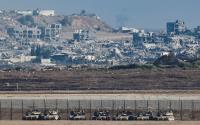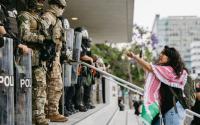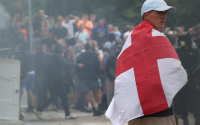8 December 2009
www.democracynow.org/2009/12/8/we_are_having_a_hard_time
While 15,000 delegates, activists and journalists are gathered here at the Bella Center for the official climate conference, a people’s summit called Klimaforum09 opened last night across town. Speakers at the Klimaforum include Sarah James, a longtime advocate for the Gwich’in people in Alaska. She traveled to Copenhagen with the Indian-born photographer Subhankar Banerjee, who has spent years documenting life in the Arctic.
Guests:
Sarah James, Gwich’in Elder from Arctic Village, Alaska
AMY GOODMAN: It’s day two of the COP15 climate change summit here in Copenhagen. Democracy Now! is the only daily global TV, radio news hour broadcasting from right here inside the Bella Center for the next two weeks.
While 15,000 delegates, activists and journalists are gathered here at the Center for the official climate conference, a people’s summit called Klimaforum09 opened last night across town. In a statement, the Klimaforum organizers write, quote, “We are here to represent ordinary concerned citizens from all around the world. We don’t represent vested interests such as bureaucrats, politicians, business or civil servants.”
Speakers at the Klimaforum include Sarah James, a longtime advocate for the Gwich’in people in Alaska. She traveled to Copenhagen with the Indian-born photographer Subhankar Banerjee, who has spent years documenting life in the Arctic.
I spoke with them last night.
SARAH JAMES: My name is Sarah James, and I’m from Arctic Village, Alaska. Climate change, global warming is real in the Arctic. There’s a lot of erosion, because permafrost is melting. When that happens, it runs off, off to another lake, another water, another body of water, when the land gives out. And then, after that, it dries up, and it cause a lot of fire and a lot of erosion. And fire dries up and causes drought.
And last summer, there was a fire all summer long, no visibility. Last spring, twenty villages got flooded along the Yukon. And along the Yukon, there’s about sixty villages within the Yukon area, villages. They never got their fish. And this year, some of their mushing dogs can’t even make it this winter. They have to give them away, or they have to kill them, so they won’t starve.
AMY GOODMAN: How has it changed your culture?
SARAH JAMES: It got so that our people don’t have the knowledge of the land anymore. And it’s confusing to us. It’s confusing to the animals and way of life in Alaska. And it’s displacing animal and displacing us. And we really have to—we’re having hard time surviving.
AMY GOODMAN: Where is Arctic Village?
SARAH JAMES: Arctic Village is Northeast Alaska, about 110 miles northeast of Arctic Circle in interior. There’s fifteen Gwich’in villages, united since 1988 to protect the coastal plain of the Arctic National Wildlife Refuge, where many birds fly. About 150 birds fly there to nest there every year from all over the world.
SUBHANKAR BANERJEE: My name is Subhankar Banerjee. I’m originally from India, now I live in the US in Santa Fe. And for the last ten years I have been—all my work has focused on the Arctic, primarily dealing with human rights issues of the indigenous communities, both the Gwich’in Nation, where Sarah James is from, as well as the Inupiaq communities.
And the reason I brought Sarah James to Copenhagen, it was a wonderful opportunity. When the curators, (Re-) Cycles of Paradise, approached me and said it’s organized by the Global Gender and Climate Alliance, I said, “How wonderful it would be to bring one of the leading American indigenous voice to Copenhagen.” So it’s more of a site-specific intervention, because at the formal Bella Center we’ll be hearing from all the politicians, ministers, and so on and so forth, but we won’t really get a chance to hear directly from someone who is experiencing climate change on a firsthand and somebody who’s really truly an American hero.
So, for me, Sarah James is my American hero. So it’s a great opportunity for me. And Sarah and I have worked together for nine years. We have done multiple events together at various universities, in DC, at Harvard and Dartmouth and multiple places. So it just feels great to be here.
AMY GOODMAN: And the Arctic, why is it so important to you as a man originally from India?
SUBHANKAR BANERJEE: Opposites attract. But as I went to the Arctic, thinking that I’m going to a faraway place remote from my home country, as it happens, Arctic is connected. Today, after ten years, I call the Arctic the most connected place on the planet. And that connection is both celebratory and tragic.
It’s celebratory because birds travel to the Arctic from every part of the planet, including from Calcutta. There is a species called yellow wagtail that winters outside of Calcutta, where I’m originally from, and nests in the Arctic National Wildlife Refuge, where I’ve been working for ten years. So that’s a celebratory connection.
And then the Arctic is getting connected to the rest of the planet in a tragic manner, climate change being, of course, at the leading edge of—affecting the Arctic. It’s the canary in the coal mine, as well as the Antarctic, but also toxicity few people know about, that—like Greenland. Breast milk of Greenland women is now scientifically considered as hazardous waste. It’s more hazardous than the trucks that you see that—hazardous waste. And that’s because these toxins are migrating from all over the planet, and they’re ending their migration in the Arctic.
So all my work is actually a metaphor for this interconnectedness. Even the exhibit I’m presenting in Copenhagen is the idea of interconnectedness, this pregnant caribou engendered theme, migrating and connecting up fifteen Gwich’in communities in USA and Alaska through their—in US and Canada through their harvest practices. And then the climate change is affecting them. So it’s this whole idea we live in a connected planet, whether economically or ecologically, but we don’t pay much attention to the ecologic side. And for me, it’s also a great human rights issue, because it’s—right to survival is one of the first rights people should have—access to their food, access to their water—and that’s being seriously threatened up in the Arctic.
AMY GOODMAN: Subhankar Banerjee is a photographer focusing on indigenous human rights. He actually lives in Santa Fe. Sarah James is the chairperson of the Gwich’in Steering Committee. She is from Arctic Village in Alaska.






